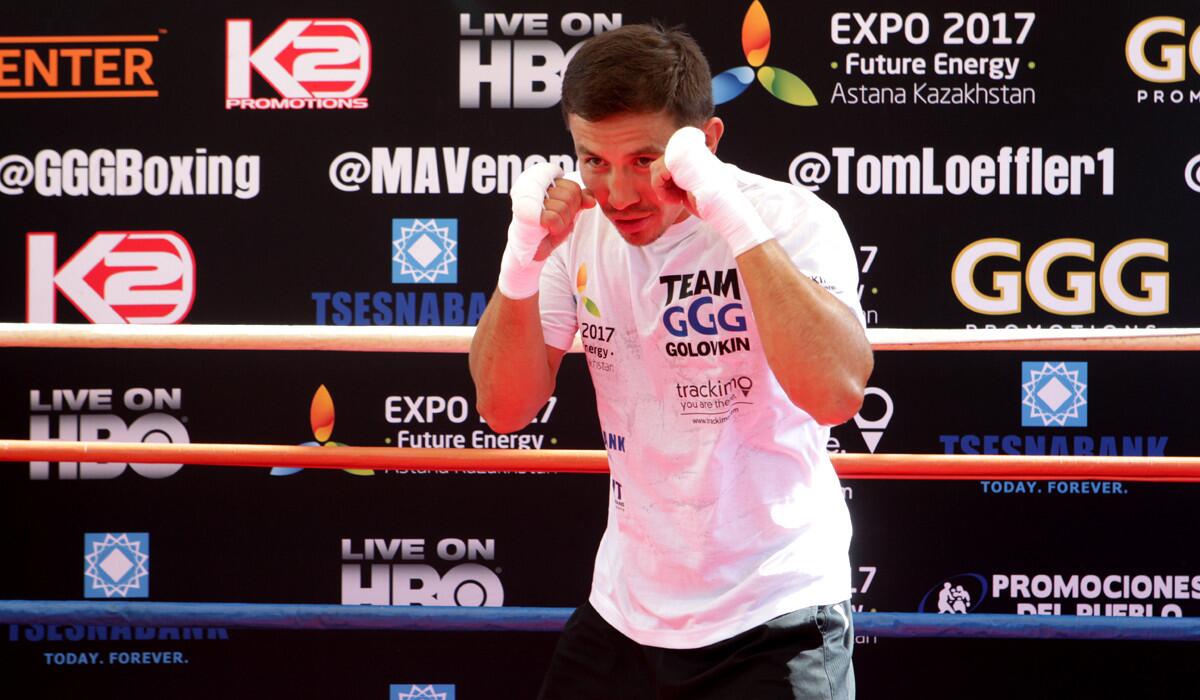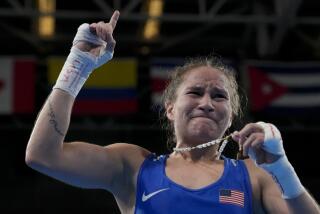Gennady Golovkin dispatches foes and boxing’s penchant for trash talk

- Share via
Saturday night’s fight card at the StubHub Center in Carson is more sneak preview than boxing show.
It’s not that Marco Antonio Rubio, the 34-year-old Mexican with a six-match winning streak, isn’t capable of giving Gennady Golovkin a decent middleweight title fight. It’s just that this is designed to be all about Golovkin, the late-rising star from Kazakhstan.
Golovkin is 32. His record is 30-0. Of those 30 victories, 27 have been knockouts. He has knocked out his last 17 opponents. If that is more than a coincidental trend, one might ponder praying for Rubio.
As things have progressed in the world of boxing recently, agreeing to fight Golovkin has become akin to agreeing to clean out the rattlesnake cage. With the snakes in it.
Boxing loves to rank and rate, not to mention rant and rave.
In the case of Golovkin, the murmur turned roar is: “He is one of the best boxers in the world.” Now, Golovkin has come to California and is doing some dreaming. He knows age 32 isn’t the springboard to a 10-to-15-year career.
“Four more years, four fights a year,” he says.
Do the math and that could be a Mayweather-esque 46-0.
That, of course, is a premature calculation, especially when there are serious flaws with Golovkin. Not with his boxing skills, work ethic or desire. Just with Golovkin.
He does not rant and rave, instead he has the personality of a Wal-Mart greeter. His smile lights up a room, and it is always there. He is courteous, well-spoken in four languages — Russian, German, Kazakh and English — and is as interested in talking about family as fights. He is a Boy Scout with powder kegs for fists. The last time he talked trash was when he took it out.
“The first time I met him,” says Abel Sanchez, trainer for the last 12 of Golovkin’s victories, “I thought, he can’t be that vicious. He’s too well-mannered.”
The first time Sanchez got a taste of Golovkin’s power, if not viciousness, was when Golovkin returned after their initial meeting and committed to training with Sanchez at Sanchez’s gym in Big Bear.
“After we had talked, he said he would be back in a couple of months,” Sanchez says, grinning about the number of fighters who have said the same and were never seen again. “Then I get a call and they say to come and pick them up, that they are here. I said, ‘Are you serious?’”
Golovkin was, and the minute they went to work, Sanchez knew, literally, what he had on his hands.
“We did the mitts,” he says. “He doesn’t like to hit me hard, doesn’t want to hurt me. He is always apologizing. But when he hit the mitts, I felt it all over, down to my toes.”
Golovkin spent 10 months of 2013 in Big Bear, living and training with Sanchez. That has given him enough taste of California to not only want to fight here more often, especially at Staples Center, but to live here. He is married to Alina, has a 5-year-old son, Vadim, and is looking for a home in California so Vadim can start his education in the United States. Golovkin says Santa Monica is among his top choices.
Golovkin left Kazakhstan for Germany in 2005, shortly after winning a silver medal in the Athens Olympics. He had prepared for the Olympics with 356 amateur fights. Never, in one of those, nor in any of his 30 pro fights, has he been knocked down.
“I don’t remember ever being hurt or having rubber legs,” he says.
He has lived in Germany ever since and fought mostly in Europe while realizing that boxing legacies can be made more quickly in the United States, especially in Las Vegas, where he has never fought.
He grew up one of four brothers. He was the son of a Kazakh coal miner and a Korean mother. The family lived in a three-room apartment in Karagandy, population about 500,000, and about 110 miles from the capital of Astana. His father was bussed to the mines, about 40 minutes away, every day.
“We didn’t have a lot,” Golovkin says, “but we often had money to buy things when there was nothing in the stores to buy. The Soviet Union was broken.”
His two older brothers became soldiers and died fighting for the Russian army. His other brother, his twin, Max, was also a top boxer who now helps manage Gennady’s career. Before the Athens Olympics, when both twins were Olympic hopefuls, Max yielded to his brother so he’d be sure to make the team.
“He said I was older,” Gennady says, “which was true — maybe 10, 15 minutes.”
His father died last year, but his mother remains in Kazakhstan and is not a huge fight fan. That’s consistent with the feelings of most mothers about boxing.
“I call her when I’m done fighting,” Golovkin says. “I tell her I’m OK and that I won.”
The word is out on Golovkin.
K2 Promotions, which handles Golovkin, was able to pocket some of its budgeted promotion money because the fight was almost an immediate sellout. In the last few days, more bleachers were added to the venue and space was made for more standing-room viewing. The attendance will be about 9,000.
The projected result would further boost the exposure of Golovkin, who has his heart set on bigger things in California and/or Las Vegas.
When the prospect comes up of him taking on the winner of the projected Miguel Cotto-Saul “Canelo” Alvarez fight in Las Vegas in May, Golovkin lights up. He has never fought on a lucrative pay-per-view card, never been on a card with that kind of prominence.
Just the thought of it makes him smile. But then, everything makes him smile.
Twitter: @DwyreLATimes
More to Read
Go beyond the scoreboard
Get the latest on L.A.'s teams in the daily Sports Report newsletter.
You may occasionally receive promotional content from the Los Angeles Times.











